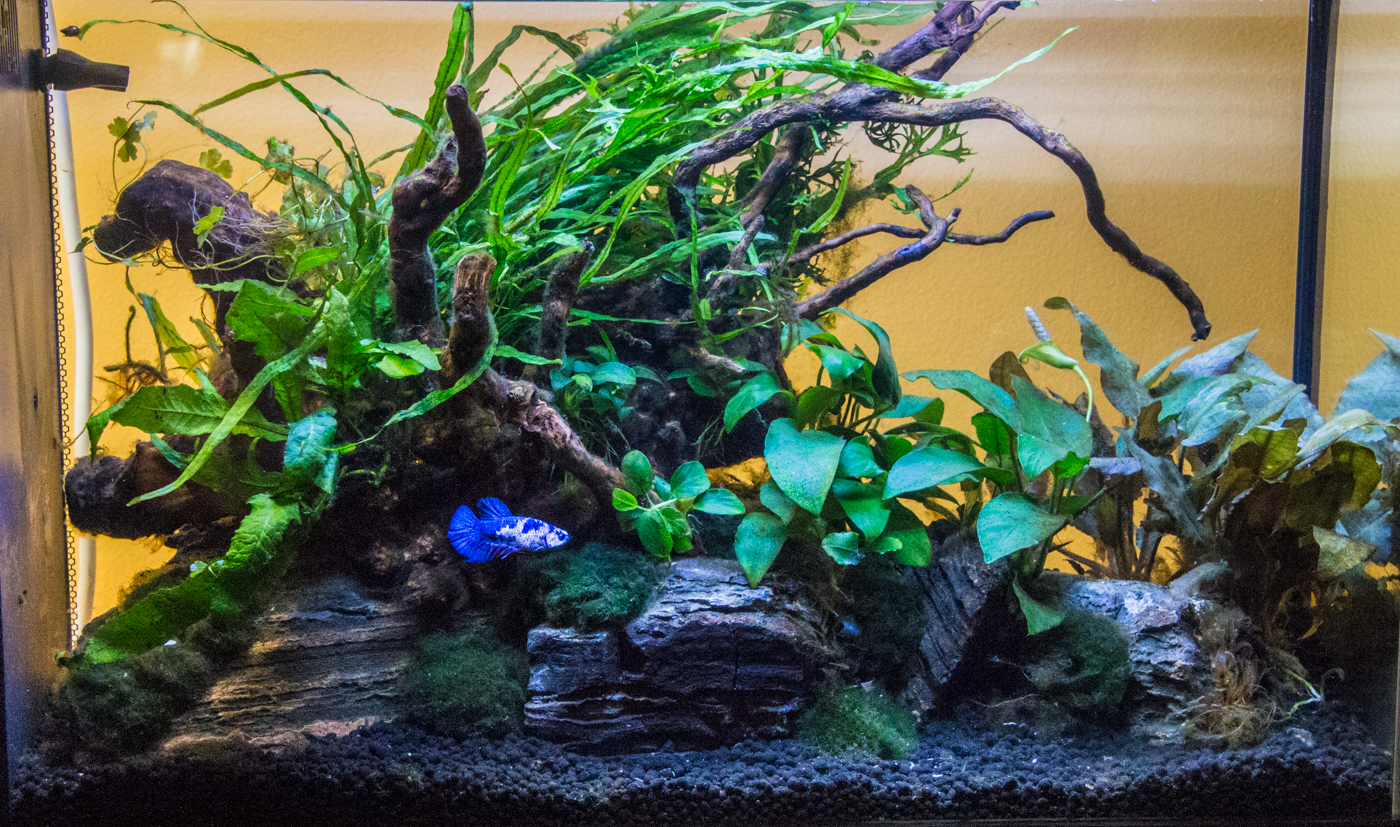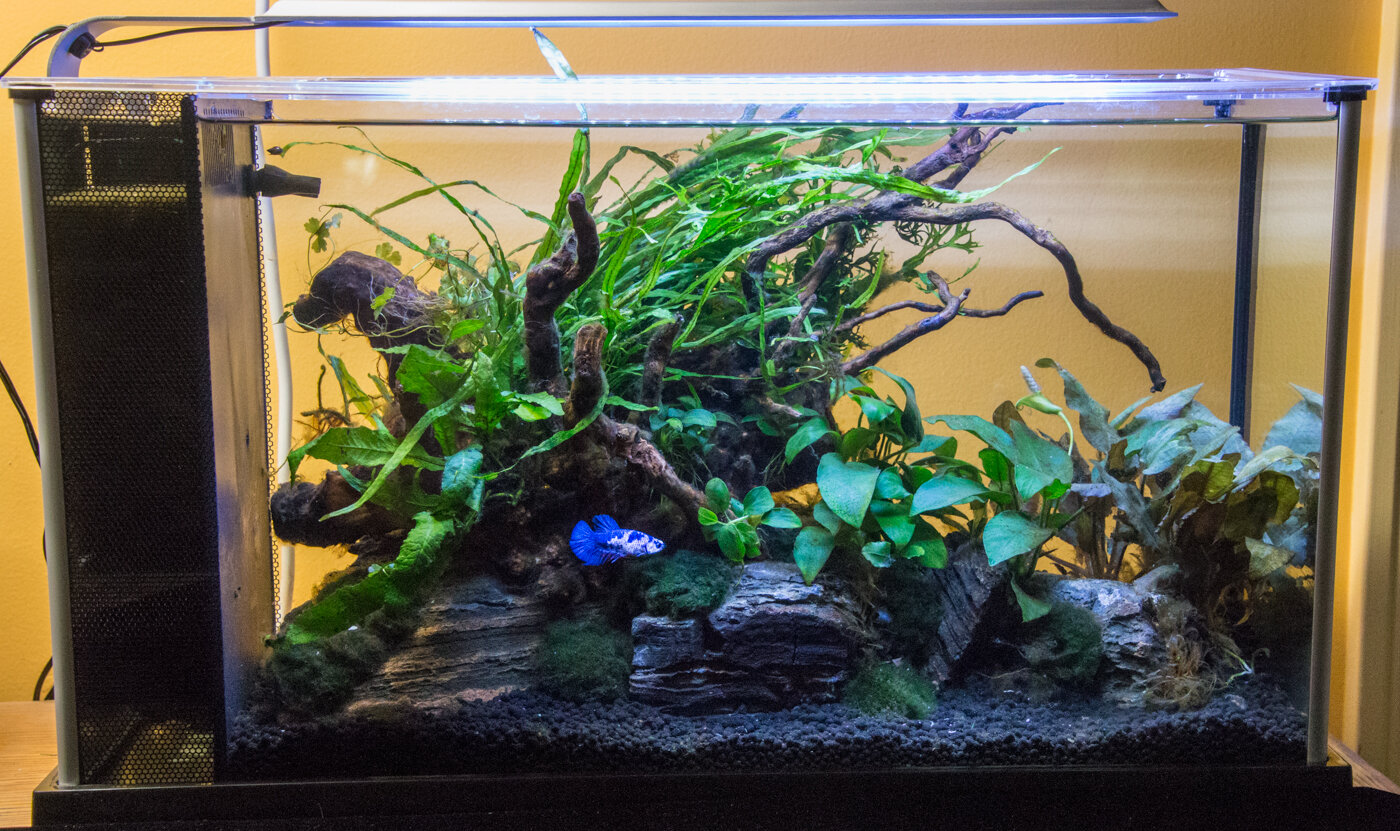Are you looking for a new hobby that combines relaxation and creativity? Creating a healthy and beautiful planted Betta aquarium might be just the thing for you! Not only will you have a stunning display of aquatic plants and colorful Betta fish, but you will also be providing a healthy and enriching environment for your aquatic pets.
In this guide, we will go over everything you need to know to create a thriving planted Betta aquarium, including selecting the right plants and fish, setting up your tank, and maintaining a healthy balance in your ecosystem. Whether you’re a seasoned aquarium enthusiast or a beginner, this guide will provide you with all the information you need to create a beautiful and healthy home for your Betta fish.
Creating a Healthy and Beautiful Planted Betta Aquarium
To create a healthy and beautiful planted Betta aquarium, start by selecting the right plants and substrate. Opt for plants such as Java Moss, Anubias, and Amazon Sword, and choose a substrate that won’t cloud the water. Next, add a heater and filter to maintain a stable environment, and use a water conditioner to remove chlorine and chloramine. Finally, add some hiding spots and decorations for your Betta to explore and enjoy.

Creating a Healthy and Beautiful Planted Betta Aquarium
Choosing the Right Tank Size
When it comes to creating a healthy and beautiful planted Betta aquarium, choosing the right tank size is crucial. Bettas require a minimum of 5 gallons of water to thrive and larger tanks are always better as they provide more space for plants and other aquatic creatures to grow. When selecting a tank, make sure it has a secure lid to prevent jumping and is made of high-quality glass or acrylic material.
It’s also important to consider the location of the tank. Avoid placing it near windows or direct sunlight as it can cause temperature fluctuations. Instead, choose a spot that is away from direct sunlight and has a stable temperature.
Adding the Right Substrate
The substrate you choose for your planted Betta aquarium is important as it provides a base for the plants to grow and helps maintain a healthy environment for your fish. When selecting a substrate, choose one that is specifically designed for planted aquariums. Some popular options include gravel, sand, and soil.
Gravel is a popular choice as it’s easy to clean and comes in a variety of colors. Sand is also a great option as it provides a natural look and is gentle on a Betta’s delicate fins. Soil is the best option for planted tanks as it contains nutrients that help plants grow and thrive.
Selecting the Right Plants
When selecting plants for your planted Betta aquarium, it’s important to choose ones that are compatible with Bettas and can thrive in an aquarium environment. Some popular options include Java fern, Amazon sword, Anubias, and Java moss.
These plants not only add beauty to your aquarium but also provide a natural habitat for your Betta. They help maintain water quality by removing excess nutrients and waste, and also provide hiding places for your fish.
Providing Proper Lighting
Lighting is an important factor in the health and growth of your plants. It’s important to choose the right lighting for your planted Betta aquarium. LED lights are a popular option as they provide a natural-looking light and are energy-efficient.
It’s also important to provide a consistent light cycle for your plants. Aim for 8-10 hours of light per day and make sure to turn off the lights at night to mimic a natural day and night cycle.
Maintaining Proper Water Parameters
Maintaining proper water parameters is crucial for the health and well-being of your Betta and plants. It’s important to monitor the water temperature, pH levels, and ammonia and nitrate levels regularly.
Bettas prefer a temperature range of 76-82°F and a pH level between 6.5-7.5. Ammonia and nitrate levels should be kept at zero. Regular water changes and gravel vacuuming are also important to maintain a healthy environment for your Betta and plants.
Adding Proper Decorations
Decorations not only add beauty to your planted Betta aquarium but also provide hiding places and resting spots for your Betta. Some popular options include driftwood, rocks, and caves.
It’s important to choose decorations that are safe for your Betta and won’t harm them. Avoid decorations with sharp edges or small holes that your Betta can get stuck in.
Feeding Your Betta Properly
Feeding your Betta properly is important for their overall health and well-being. Betta’s are carnivorous and require a diet that is high in protein.
Some popular food options include pellets, frozen or live brine shrimp, and bloodworms. It’s important to avoid overfeeding your Betta as it can lead to obesity and other health issues.
Keeping the Tank Clean
Keeping your planted Betta aquarium clean is important for the health and well-being of your Betta and plants. Regular water changes and gravel vacuuming are important to remove excess waste and debris.
It’s also important to clean the filter regularly to maintain water quality. Avoid using harsh chemicals or cleaning agents as they can harm your Betta and plants.
Benefits of a Planted Betta Aquarium
A planted Betta aquarium not only adds beauty to your home but also provides numerous benefits. The plants help maintain water quality by removing excess nutrients and waste, and also provide hiding places for your Betta.
The aquarium also provides a natural habitat for your Betta, reducing stress and promoting overall health. It’s a great way to create a peaceful and relaxing environment in your home.
Planted Betta Aquarium Vs. Traditional Aquarium
A planted Betta aquarium has numerous advantages over a traditional aquarium. The plants help maintain water quality, reducing the need for frequent water changes.
The plants also provide a natural habitat for your Betta, reducing stress and promoting overall health. A planted aquarium is also more aesthetically pleasing and provides a peaceful and relaxing environment in your home.
Conclusion
Creating a healthy and beautiful planted Betta aquarium requires careful planning and attention to detail. Choosing the right tank size, substrate, plants, lighting, and decorations, as well as maintaining proper water parameters and feeding your Betta properly, are all crucial factors in creating a thriving aquarium.
A planted Betta aquarium not only adds beauty to your home but also provides numerous benefits for your Betta and plants. It’s a great way to create a peaceful and relaxing environment in your home and enjoy the beauty of nature.
Frequently Asked Questions
In this section, we will answer some of the most common questions about creating a healthy and beautiful planted Betta aquarium. Whether you’re a beginner or an experienced hobbyist, these answers will help you maintain a thriving aquatic environment for your Betta fish.
1. What are the benefits of a planted Betta aquarium?
There are numerous benefits to having a planted Betta aquarium. First, live plants improve water quality by absorbing excess nutrients and waste. This creates a healthier environment for your Betta fish and reduces the need for frequent water changes. Additionally, plants provide natural hiding places for your Betta which reduces stress and improves overall wellbeing. Finally, a planted aquarium is visually stunning, adding a touch of nature to any room.
When selecting plants for your Betta aquarium, choose species that are suitable for your tank size and lighting conditions. Avoid plants that require high levels of maintenance, as they can be difficult to care for. Some great beginner-friendly plants include Java Fern, Anubias, and Amazon Sword.
2. How do I maintain a healthy planted Betta aquarium?
Maintaining a healthy planted Betta aquarium requires regular maintenance and attention to detail. First, ensure that your aquarium is properly cycled before adding any fish or plants. This involves establishing a colony of beneficial bacteria that convert toxic ammonia and nitrite into less harmful nitrate. Additionally, perform regular water changes of 20-30% every 1-2 weeks to remove excess nutrients and maintain water quality.
When caring for your live plants, ensure that they receive enough light and nutrients. This can be achieved through the use of a high-quality LED light and a liquid fertilizer. Finally, monitor your Betta’s behavior and appearance for signs of stress or illness. Common signs of stress include lethargy, loss of appetite, and frayed fins. If you notice any of these symptoms, take immediate action to address the issue.
3. Can I keep other fish with my Betta in a planted aquarium?
While Betta fish are known for their aggressive behavior, they can coexist peacefully with certain species of fish in a planted aquarium. Some good tankmates for Betta fish include small schooling fish such as neon tetras and ember tetras. Additionally, bottom-dwelling fish such as corydoras catfish and Otocinclus can also be kept with Betta fish.
When selecting tankmates for your Betta, ensure that they are compatible in terms of water parameters and temperament. Avoid keeping other aggressive fish or fish that require vastly different water conditions. Additionally, ensure that your aquarium is large enough to accommodate all of your fish comfortably.
4. How do I prevent algae growth in my planted Betta aquarium?
Algae growth is a common issue in planted aquariums, but it can be prevented with proper maintenance and management. First, ensure that your aquarium receives the appropriate amount of light. Too much light can promote algae growth, while too little light can stunt plant growth. Additionally, avoid overfeeding your fish as excess food can contribute to algae growth.
If you do notice algae growth in your aquarium, there are several steps you can take to address the issue. These include reducing the amount of light your aquarium receives, performing more frequent water changes, and manually removing algae with a scrubber or algae scraper. Additionally, you can introduce algae-eating fish such as Siamese algae eaters or Amano shrimp to help control algae growth.
5. How do I set up a planted Betta aquarium?
Setting up a planted Betta aquarium involves several key steps. First, select an appropriate tank size for your Betta and any potential tankmates. Next, install a high-quality filter and heater to maintain water quality and temperature. Add a layer of substrate to the bottom of your aquarium and place your plants in the substrate. Finally, fill your aquarium with water and allow it to cycle for several weeks before adding any fish.
When selecting plants for your aquarium, choose species that are suitable for your tank size and lighting conditions. Additionally, ensure that your plants receive enough nutrients and light to grow properly. Finally, monitor your aquarium’s water quality and perform regular maintenance to ensure a healthy and thriving aquatic environment for your Betta fish.

How to make THE BEST Betta Fish Tank | You Suck At Fish Tanks
In conclusion, creating a healthy and beautiful planted Betta aquarium requires a combination of knowledge, patience, and dedication. By researching the specific needs of Betta fish and selecting the right plants, lighting, and filtration, you can create a thriving aquatic ecosystem that benefits both your fish and the environment.
Not only will a well-maintained Betta aquarium provide a stunning display for your home or office, but it can also have a positive impact on your mental health and well-being. Watching the peaceful movements of your fish and the vibrant colors of your plants can be a calming and relaxing experience, helping to reduce stress and anxiety.
By investing time and effort into your planted Betta aquarium, you can create a beautiful and rewarding hobby that brings joy and tranquility to your life. With proper care and attention, your Betta fish can thrive in a healthy and natural environment, providing you with endless hours of enjoyment and relaxation.
